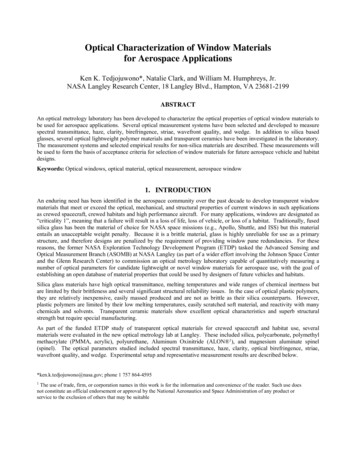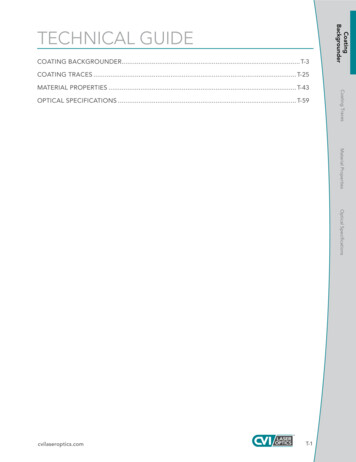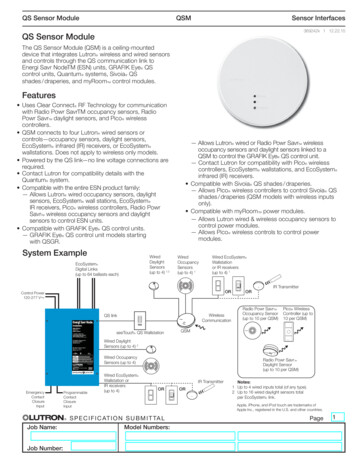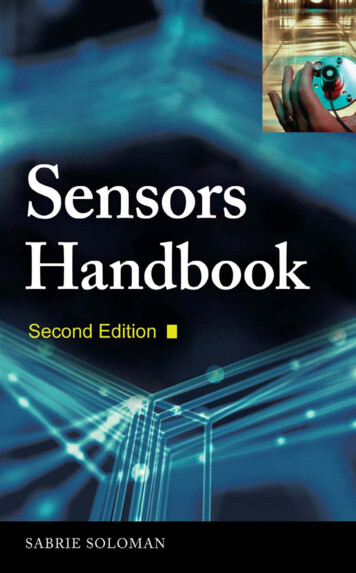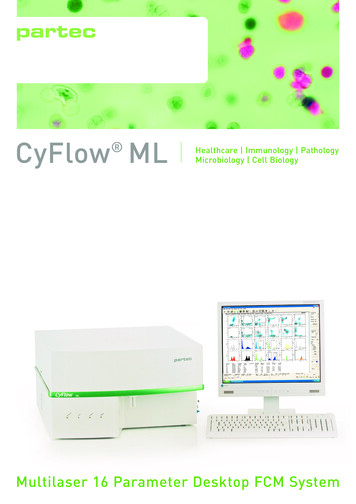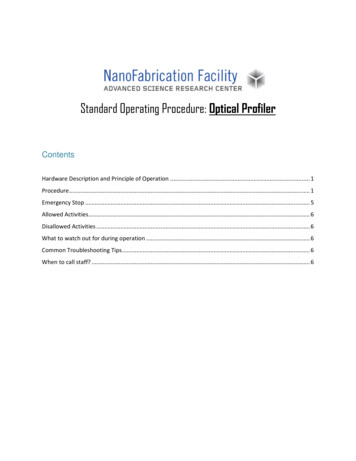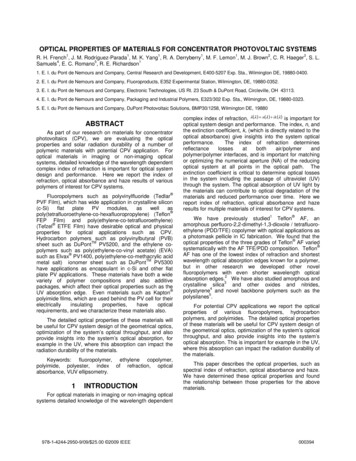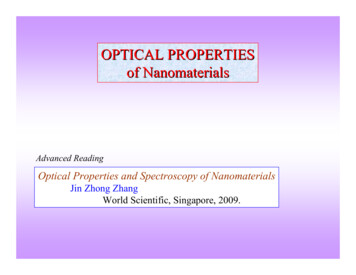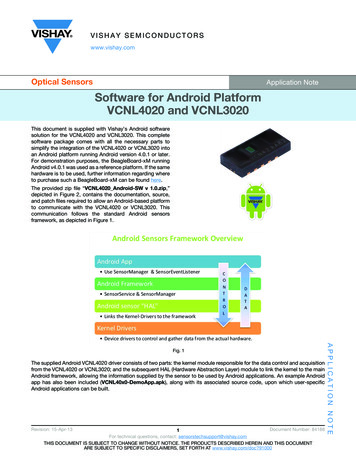
Transcription
VISHAY SEMICONDUCTORSwww.vishay.comOptical SensorsApplication NoteSoftware for Android PlatformVCNL4020 and VCNL3020This document is supplied with Vishay’s Android softwaresolution for the VCNL4020 and VCNL3020. This completesoftware package comes with all the necessary parts tosimplify the integration of the VCNL4020 or VCNL3020 intoan Android platform running Android version 4.0.1 or later.For demonstration purposes, the BeagleBoard-xM runningAndroid v4.0.1 was used as a reference platform. If the samehardware is to be used, further information regarding whereto purchase such a BeagleBoard-xM can be found here.The provided zip file “VCNL4020 Android-SW v 1.0.zip,”depicted in Figure 2, contains the documentation, source,and patch files required to allow an Android-based platformto communicate with the VCNL4020 or VCNL3020. Thiscommunication follows the standard Android sensorsframework, as depicted in Figure 1.The supplied Android VCNL4020 driver consists of two parts: the kernel module responsible for the data control and acquisitionfrom the VCNL4020 or VCNL3020; and the subsequent HAL (Hardware Abstraction Layer) module to link the kernel to the mainAndroid framework, allowing the information supplied by the sensor to be used by Android applications. An example Androidapp has also been included (VCNL40x0-DemoApp.apk), along with its associated source code, upon which user-specificAndroid applications can be built.Revision: 15-Apr-13Document Number: 841881For technical questions, contact: sensorstechsupport@vishay.comTHIS DOCUMENT IS SUBJECT TO CHANGE WITHOUT NOTICE. THE PRODUCTS DESCRIBED HEREIN AND THIS DOCUMENTARE SUBJECT TO SPECIFIC DISCLAIMERS, SET FORTH AT www.vishay.com/doc?91000APPLICATION NOTEFig. 1
Application Notewww.vishay.comVishay SemiconductorsSoftware for Android PlatformVCNL4020 and VCNL3020Fig. 2DOCUMENTATIONThe provided documentation files are Development Documentation.pdf and Integration Guide.pdf.The Development Documentation file describes how the sources are to be compiled in order to be used with the referenceplatform. When successfully compiled, the kernel and HAL modules are generated. In order to further simplify the build process,a build script is supplied, which is also documented in this file.The Integration Guide file describes how the VCNL4020 or VCNL3020 is to be integrated with the BeagleBoard xM. Adescription of both the kernel and the user space Android HAL module required for the integration is supplied. Furthermore, thedocument supplies information regarding the source files used to build these modules, which are also included in the zip file.The modules patches and the corresponding sources are supplied both in the form of the integration patch for all devicerepositories and specifically for the integration into the HAL of the reference repository. Information on how to apply thesepatches is also given in the guide.INCLUDED FILESAPPLICATION NOTEFigure 3 includes an overview of the files supplied with the VCNL4020 software package.Fig. 3The DemoApp folder contains the demonstration app along with its source code.The Sources folder contains all the necessary sources in order to compile the required Android kernel and HAL patches. Furtherinformation regarding the files located in the sub folders can be found in the Integration Guide. The current versions of thecompiled patches can be found in the Patches folder. If the source code is expanded and the source needs to be recompiled,the build script used to ease this process is located in the Misc folder.The remaining VirtualMachine folder contains an incomplete virtual machine for our set-up build environment. The folder isincomplete as it is only needed for our own evaluation with the BeagleBoard-xM reference platform. The entire environment hasnot been included as the zip file size would increase to about 50 GB. However, if the build environment is required, pleasecontact sensorstechsupport@vishay.com.Revision: 15-Apr-13Document Number: 841882For technical questions, contact: sensorstechsupport@vishay.comTHIS DOCUMENT IS SUBJECT TO CHANGE WITHOUT NOTICE. THE PRODUCTS DESCRIBED HEREIN AND THIS DOCUMENTARE SUBJECT TO SPECIFIC DISCLAIMERS, SET FORTH AT www.vishay.com/doc?91000
Application Notewww.vishay.comVishay SemiconductorsSoftware for Android PlatformVCNL4020 and VCNL3020 BEAGLEBOARD-XM EXPANSIONThe development was done using the BeagleBoard-xM as a reference platform, with the VCNL4020 sensor board connectedvia the expansion connector. This connector provides the I2C lines required to interface with the VCNL4020 or VCNL3020. Thegeneral set-up is shown in Figure 4.Fig. 4APPLICATION NOTEThis interconnection board takes care of the I2C bus as well as the needed power supply. The 3.3 V supply voltage for the sensoris created by a small voltage regulator tied to 5 V. The necessary I2C bus pull-up resistors are connected to 1.8 V. Theconnections are depicted in Figure 5.Fig. 5Revision: 15-Apr-13Document Number: 841883For technical questions, contact: sensorstechsupport@vishay.comTHIS DOCUMENT IS SUBJECT TO CHANGE WITHOUT NOTICE. THE PRODUCTS DESCRIBED HEREIN AND THIS DOCUMENTARE SUBJECT TO SPECIFIC DISCLAIMERS, SET FORTH AT www.vishay.com/doc?91000
Application Notewww.vishay.comVishay SemiconductorsSoftware for Android PlatformVCNL4020 and VCNL3020VCNL40x0 DEMO APPThe Android software package comes with an Android demonstration app, VCNL40x0-DemoApp.apk, which can be run onany Android platform running v.4.0.1 or higher. It is to be used both for testing purposes and by developers as a base for buildingfurther Android applications.To install this .apk, simply use an Android file manager such as “ASTRO File Manager” or copy the file onto a webserver in order to open the file via a link directly from the phone. The Android Debug Bridge can also be used with thecommand: adb install -r application.apk .After successful installation, the icon shown in Figure 6 will be added to your home screen.Fig. 6APPLICATION NOTESelecting the icon will launch the application and take you to the “Proximity” tab, as shown in Figure 7.Fig. 7The displayed information shows that the device is successfully communicating with the VCNL4020 or VCNL3020. The “Value”is an indication of the information sent to the app through the Android sensor manager. This value changes to 0.0 when an objectis within 5 mm of the sensor, as a proximity event has been through the Android sensor API. The "Sensor Enabled" buttonregisters the app for system updates. Revision: 15-Apr-13Document Number: 841884For technical questions, contact: sensorstechsupport@vishay.comTHIS DOCUMENT IS SUBJECT TO CHANGE WITHOUT NOTICE. THE PRODUCTS DESCRIBED HEREIN AND THIS DOCUMENTARE SUBJECT TO SPECIFIC DISCLAIMERS, SET FORTH AT www.vishay.com/doc?91000
Application Notewww.vishay.comVishay SemiconductorsSoftware for Android PlatformVCNL4020 and VCNL3020Selecting the “Ambient Light” tab will display the ambient light menu, as shown in Figure 8.Fig. 8Again the sensor information is read and displayed and the “Sensor Enabled” button registers the app for system updates. The“Value” field continuously updates with the current ambient light value as read by the VCNL4020. Note that the VCNL3020 doesnot contain an ambient light sensor.APPLICATION NOTEThe “LocalFile” tab brings up a blank screen unless the VCNL4020 is being used (Figure 9).Fig. 9Revision: 15-Apr-13Document Number: 841885For technical questions, contact: sensorstechsupport@vishay.comTHIS DOCUMENT IS SUBJECT TO CHANGE WITHOUT NOTICE. THE PRODUCTS DESCRIBED HEREIN AND THIS DOCUMENTARE SUBJECT TO SPECIFIC DISCLAIMERS, SET FORTH AT www.vishay.com/doc?91000
Application Notewww.vishay.comVishay SemiconductorsSoftware for Android PlatformVCNL4020 and VCNL3020After setting up the reference platform and applying the patches, the LocalFile menu displays what is shown in Figure 10.Fig. 10Here the current status of the proximity and ambient light measurements are displayed, along with the corresponding thresholdvalues. If the “Refresh” button on the bottom left is toggled ON, these values are continuously updated and the latest valuesread by the VCNL4020 sensor are shown.The “Reset” button resets the values along with the threshold values. For example, if the environment is changed by placingglass over the sensor - as it would be in a mobile phone - the “Reset” button can be pressed after the glass has been put intoplace. The proximity detection in the Proximity menu will now react to the newly set threshold, taking the new offset values intoconsideration.APPLICATION NOTEThe new threshold values are taken and the new upper limit is set 200 counts above this. The new lower limit used toswitch on again is taken as half the upper limit counts (i.e. 100 counts). These values are displayed as “Threshold max.”and “Threshold min.” in the logging data.Further information such as the amount of measurements taken, “iCountStatus,” or an average of the measured proximityvalues, “Av,” is also displayed.REMARK:This Android software may also be used for the VCNL4010 without any changes.Revision: 15-Apr-13Document Number: 841886For technical questions, contact: sensorstechsupport@vishay.comTHIS DOCUMENT IS SUBJECT TO CHANGE WITHOUT NOTICE. THE PRODUCTS DESCRIBED HEREIN AND THIS DOCUMENTARE SUBJECT TO SPECIFIC DISCLAIMERS, SET FORTH AT www.vishay.com/doc?91000
The provided documentation files are Development Documentation.pdf and Integration Guide.pdf. The Development Documentation file describes how the sources are to be compiled in order to be used with the reference platform. When successfully compiled, the kernel and HAL modules are ge nerated. In order to furt her simplify the build process,


